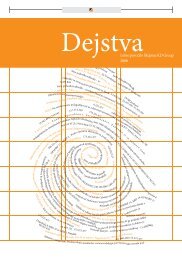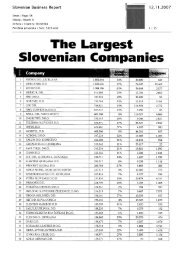The Group KD Group and KD Group dd
The Group KD Group and KD Group dd
The Group KD Group and KD Group dd
You also want an ePaper? Increase the reach of your titles
YUMPU automatically turns print PDFs into web optimized ePapers that Google loves.
<strong>The</strong> <strong>Group</strong> <strong>KD</strong> <strong>Group</strong> Annual Report 2009<br />
Notes to Consolidated Financial Statements as at <strong>and</strong> for the year ended 31 December 2009<br />
2.11 Offsetting financial instruments<br />
Financial assets <strong>and</strong> liabilities are offset <strong>and</strong> the net amount reported in the balance sheet only when there is a legally<br />
enforceable right to offset the recognised amounts <strong>and</strong> there is an intention to settle on a net basis, or to realise the asset <strong>and</strong><br />
settle the liability simultaneously.<br />
2.12 Cash <strong>and</strong> cash equivalents<br />
Cash <strong>and</strong> cash equivalents include cash in h<strong>and</strong> <strong>and</strong> dem<strong>and</strong> deposits held with banks. <strong>The</strong> <strong>Group</strong> reports cash flows from<br />
operating activities using the indirect method, whereby profit or loss is restated for the effects of transactions of a non-cash<br />
nature, any deferrals or accruals of past or future operating cash receipts or payments, <strong>and</strong> items of income or expense<br />
associated with investing or financing cash flows.<br />
2.13 Share capital <strong>and</strong> dividend distribution<br />
Ordinary <strong>and</strong> preference shares are equity. Incremental costs directly attributable to the issue of new shares or options or to<br />
the acquisition of a business are shown in equity as a deduction, net of tax, from the proceeds.<br />
Where the Company or another member of the <strong>Group</strong> purchases the Company's equity share capital, the consideration paid<br />
is deducted from total shareholders’ equity. Where such shares are subsequently sold or reissued, any consideration received<br />
is included in the shareholders’ equity.<br />
Dividends on ordinary <strong>and</strong> preference shares are recognised as a liability in the period in which they are approved by the<br />
Company's shareholders. Dividends for the year that are declared after the balance sheet date <strong>and</strong> before the financial<br />
statements are authorised for issue are disclosed in the subsequent events note (see Note 30).<br />
2.14 Insurance <strong>and</strong> investment contracts<br />
<strong>The</strong> <strong>Group</strong> issues contracts that transfer insurance risk or financial risk, or both. Insurance contracts are those contracts that<br />
transfer significant insurance risk. Such contracts may also transfer financial risk. As a general guideline, the <strong>Group</strong> defines<br />
as significant insurance risk the possibility of having to pay benefits on the occurrence of an insured event that are at least<br />
10% above the benefits payable if the insured event did not occur.<br />
Investment contracts are those contracts that transfer financial risk with no significant insurance risk.<br />
Traditional life insurance contracts <strong>and</strong> investment contracts include the possibility of discretionary participation in the positive<br />
result realised through management of assets from said contracts (hereinafter: DPF). <strong>The</strong> possibility of discretionary<br />
participation is a contractual right to a<strong>dd</strong>itional benefits supplementary to guaranteed benefits, namely:<br />
- benefits which are likely to represent a significant share of the total contract benefits;<br />
- benefits whose amount or time frame is specified by the insurer; <strong>and</strong><br />
- benefits which are contractually based on:<br />
• the success of a given category of contracts or certain types of contracts;<br />
• realised <strong>and</strong>/or unrealised investment returns on a specific pool of assets held by the issuer; or<br />
• the profit of the company, cover of assurance or other entity that issues the contract.<br />
Traditional life insurance contracts with DPF <strong>and</strong> investment contracts with DPF contain an agreed insurance sum or annuity<br />
(calculated under the premise of achieving a certain rate of return on accumulated assets) <strong>and</strong> an a<strong>dd</strong>itional possibility of the<br />
insured’s participation in the <strong>Group</strong>’s realised profits in the segments of life insurance <strong>and</strong> annuity insurance at the end of the<br />
financial period <strong>and</strong>/or with regard to the profitability of assets if higher than the pre-calculated amounts. <strong>The</strong> basis for<br />
determining the amounts of discretionary participation of the insured <strong>and</strong> the percentage vary between individual insurance<br />
products <strong>and</strong> are defined in the insurance terms.<br />
Insurance <strong>and</strong> financial life insurance contracts are defined as contracts with DPF because the interest rate used at the time<br />
of preparing the product <strong>and</strong> calculating the agreed insurance sum or annuity was lower than the expectations at the time with<br />
regard to commercial interest rates. A<strong>dd</strong>itional benefits for the policyholder were expected at the stage of preparing the<br />
insurance product, which represents a discretionary right to a<strong>dd</strong>itional benefits.<br />
96







